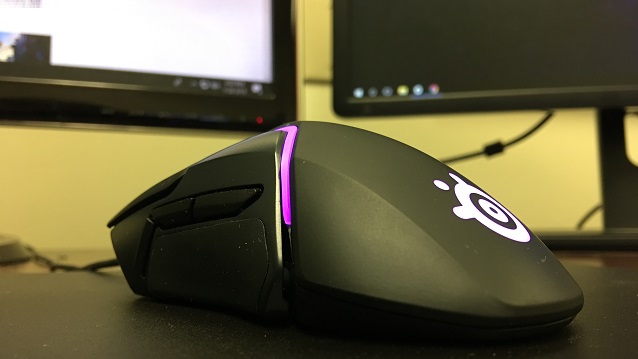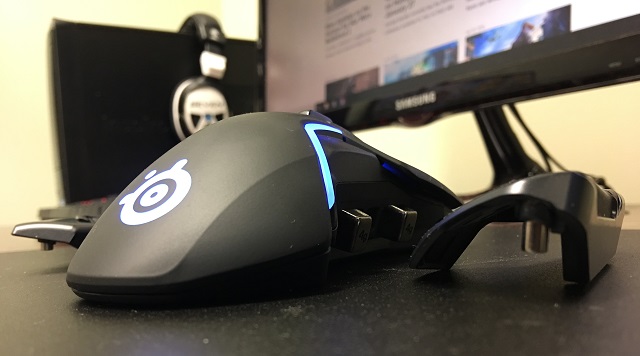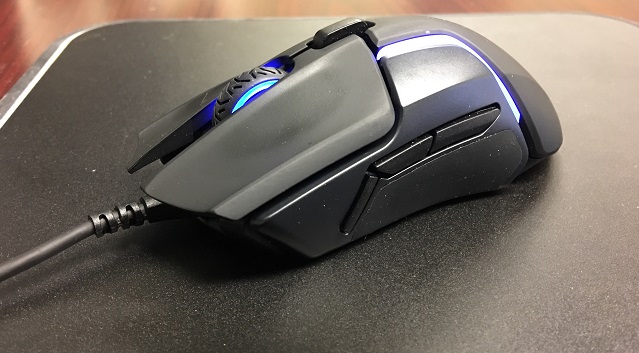Finding the right gaming mouse is like finding a snug glove in winter — it’s warm, it’s toasty, and it’s protection from the bitter chill of losing yet another ranked match in Paladins. Finding the right gaming mouse can also be an elusive prospect, one that’s made difficult by the overwhelming glut of mice filling every peripherals storefront on the internet.
In all my time reviewing mice over the past year, I’ve found two that I could definitively say are the right fit for my hybrid grip style — and can keep up with the way I play video games on the PC. Sure, there’ve been some great mice to come across my desk, but only a small handful really stand out across the vast expanse of time. Now, I’ve found another.
SteelSeries’ Rival 600 is a phenomenally engineered piece of gaming hardware. It’s a mouse that should be on every gamer’s desk — casual or competitive. Because of its TrueMove3+ sensor set (yes, it has two sensors), the 600 sets itself apart from the competition in a unique way. It’s the mouse I never knew I wanted until I got my hands on it.
And now I can’t let go.

Design
If you were to take a cursory glance at the Rival 600, you’d probably walk away thinking it looks a lot like the Rival 310. In fact, the 600 has a (very) similar shape and contour when compared to its TrueMove cousin. But take a closer look and it’s immediately apparent that when it comes to design, the Rival 600 is fiercer and much more aggressive.
Where the left and right mouse buttons of the Rival 310 stop at the prow of the mouse, the split-trigger switches of the Rival 600 reach out over the front of the mouse like prongs on a cyberpunk starship, lending the mouse a futuristic aesthetic that fits well with modern gaming’s RGB, space-age zeal. Move along the top toward the middle of the Rival 600, and you’ll find the obligatory mouse wheel and a relatively large middle mouse button for switching CPI on the fly. I found the 310’s middle button a bit small, so I was glad to see the surface area of the 600’s MMB grow to allow for easier access in tense situations.
From there, move along the left side of the mouse and you’ll find three more buttons along the periphery, just above the absurdly comfortable silicone grips. These buttons aren’t as large as those found on the 310; their slimmer designs don’t provide large targets for your thumbs. But considering the 600 isn’t as tall in the middle and the back as the 310, the 600 fit in my palm better and helped my thumb easily find each button without any problems.
As is customary with the Rival series of mice, you’ll find the SteelSeries logo branded on the back of the Rival 600. But what isn’t customary is the mouse’s eight-zone RGB lighting. Hop into this clicker’s Engine 3 software and you’ll find that you can not only adjust the lighting beneath the SteelSeries logo, but also the lighting beneath the mouse wheel and in the channels just below the LMB and RMB. The latter conduits add character to the Rival 600 — offsetting its rather austere all-black color pattern. Using Engine 3, you can cycle through four different effects and millions of colors to program the perfect combination of lush, vibrant lighting.
But one of the very best things about the Rival 600’s design is that it has detachable side plates that let you customize the weight of the mouse. Coming it at around 96 grams without its detachable cable, the Rival 600 is already one of SteelSeries’ heavier mice right out of the box. However, by detaching the sides and inserting one or all of the included eight four-gram weights, you can get the Rival 600 up to 128 grams, making it the perfect choice for those that prefer weight customizability for different gaming situations. It also helps that the weights are on the sides of the mouse — not the middle — allowing for more pinpoint customization than that found in some other models.

Performance
Featuring SteelSeries’ TrueMove3 Sensor (here called TrueMove3+), the Rival 600 provides fantastic accuracy and performance. Just like the Rival 310’s TrueMove3, the 600’s TrueMove3+ eschews jitters and jerks for ultra-low latency and what really does feel like true 1-to-1 tracking up to 3,500 CPI. The mouse can reach 12,000 CPI, but SteelSeries can only guarantee 1-to-1 tracking up to 3,500. Regardless, in the same ways I adored the Rival 310 for making Paladins headshots effortless, and in how I praised it for increasing my accuracy while sniping in Battlefield 1, the Rival 600 gave me the accuracy and precision I needed to stay competitive.
But what really makes the Rival 600 stand apart from every other mouse on the planet is that it sports not one but two sensors. Putting the + in TrueMove3+, the Rival 600’s dedicated lift-off sensor lets you calibrate the mouse’s lift-off distance from 0.5mm to 2mm via SteelSeries Engine 3 software.
Since I’m one of those players that picks his mouse up as he moves it back and forth, I found the 600’s liftoff sensor to be a savior when playing They Are Billions. By setting the liftoff distance in the middle, I was able to select specific units and structures without having my mouse stop in the middle of my movement — saving valuable seconds. Playing Killing Floor 2 and setting the lift-off distance as low as possible, I was able to better home in on targets and pull off more crits because my crosshair didn’t float off target.
There’s nothing worse than getting killed because you lifted your mouse just a hair — and now you’re staring at the ground or at a wall, not the enemy. The Rival 600 all but eliminates that in the eyes of this average Joe.
SteelSeries wants the Rival 600 to be the go-to mouse for eSports players the world over. Whether they share my sentiments remains to be seen, but I think the 600 has a shot of making that goal a reality.

Verdict
The Rival 600’s spoiled me. Having the ability to customize my lift-off distance was a functionality I never knew I wanted in a mouse until I had it — and I don’t know if I can ever go back to a mouse with a single sensor. Coming in at $79.99, the Rival 600 is a high-end mouse at a great price point. Comparing it to SteelSeries’ other offerings, the 600 should be the company’s flagship. Hands down.
Rated for 60 million clicks, the 600’s buttons are going to last you a long, long time. Using SteelSeries Engine 3 software, you can program profiles to the mouse for both lighting and functionality, easily recalling them even if you don’t have the software installed on the computer you’re using. And the mouse’s USB cable is detachable, making it easier to transport between LANs if that’s your thing.
If you’re looking for a mouse with a veritable bevy of buttons, you might find the Rival 600’s seven buttons a little on the light side. If so, you’ll want to check out SteelSeries’ Rival 500, which boasts a whopping 15 buttons and is specifically made for MMO and MOBA players. And if you’re looking for something feather-light, you’ll want to look elsewhere, too.
However, the Rival 600 is your go to if you’re looking for a generalist mouse that performs well across all genres, lets you customize lift-off distance, and provides killer accuracy and precision.
You can buy the Rival 600 on Amazon for $79.99.
[Note: SteelSeries provided the Rival 600 used for this review.]







Published: Jan 29, 2018 11:23 am